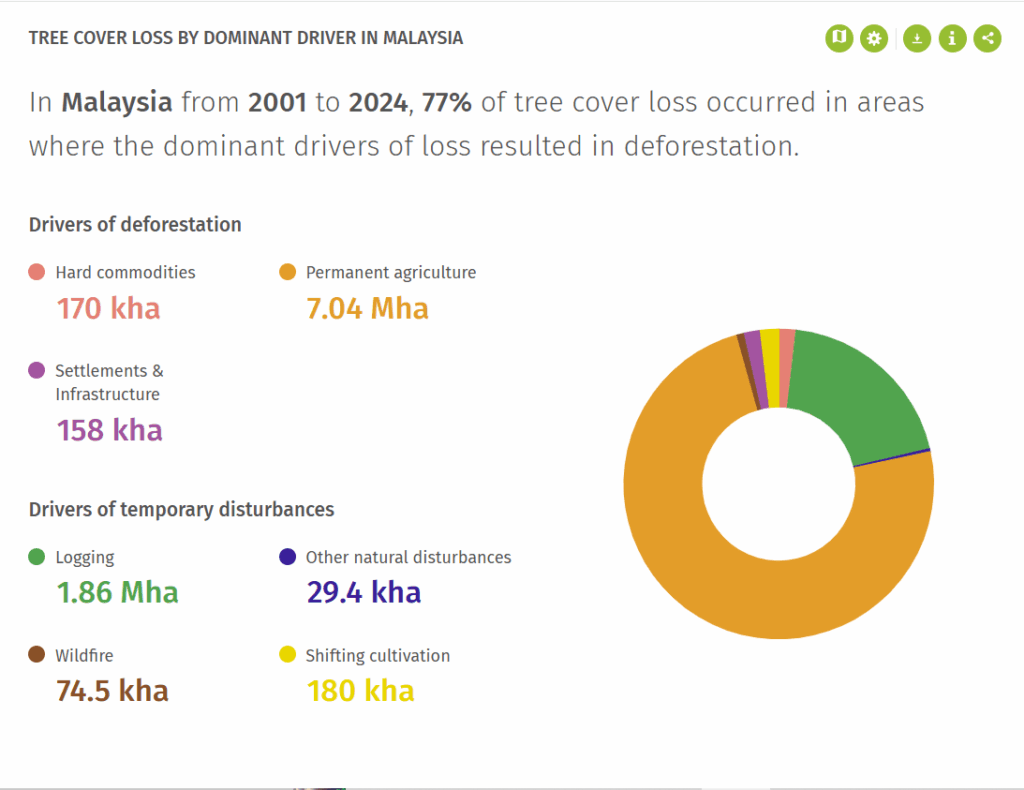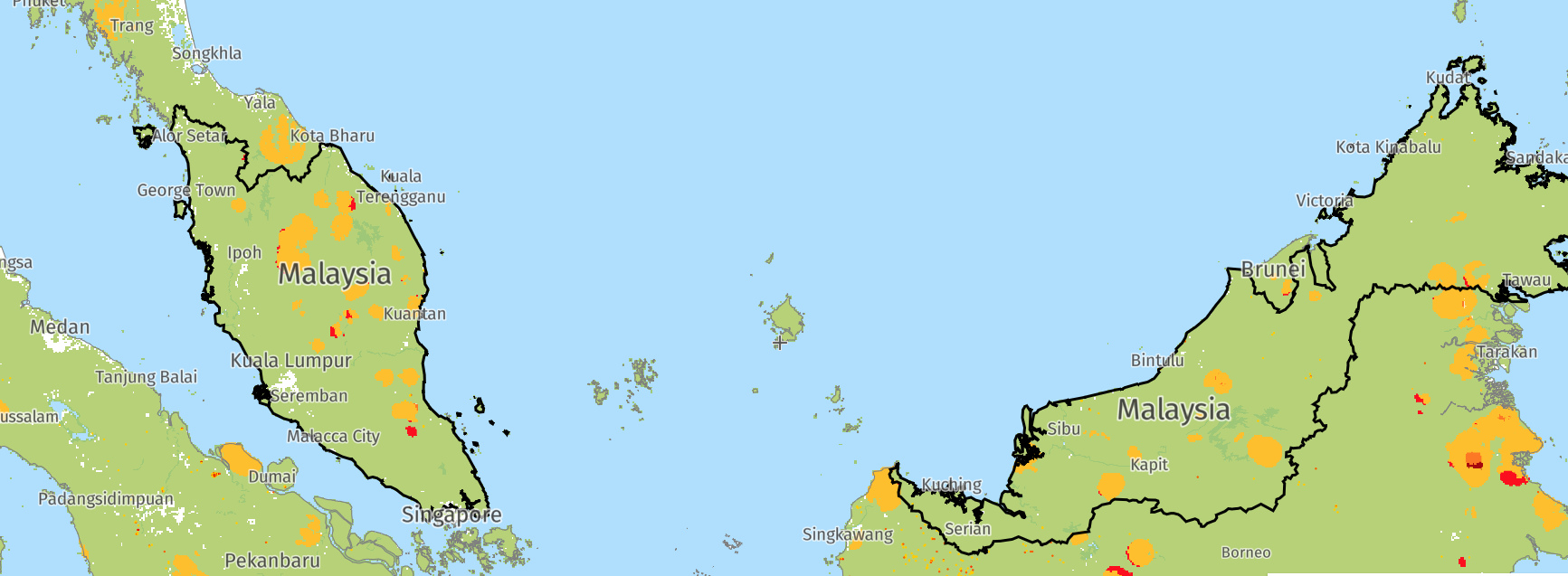By Shanti Ayadurai
KUALA LUMPUR, Aug 17: The haze was thick in several parts of Malaysia in mid July. While rain, real or engineered, has been clearing quite a bit of the pollutants, the skies are really not so blue these days. While industrial activities, vehicles emissions are among the contributors to grey skies — deforestation and fires –, which are even more preventable, have a big part.
Fires due to land clearance for agriculture in Indonesia, was cited as the cause for the recent episode of transboundary haze. But, what about the continued fire and deforestation alerts reported in many of the states in Malaysia including Sarawak, Sabah, Pahang, Perak and Kelantan in the past few weeks, months, including in intact forests, primary forests and protected areas?
These, often unnoted, events have continued to inch into the rainforests of the country and their ensuing impact on soil, water and air pollution, have only risen over the years. With Malaysia having pledged on cutting down its carbon emissions, it is also unclear how such developments can contribute towards bringing down carbon emissions?
For now most of the states’ carbon emission is higher than their carbon sink.
While the forestry business is a revenue earner for the country and provides employment for thousands of workers, with a good number of them being foreign workers, the encroachment into the non-production forest areas has been growing in the recent years.
While Malaysia can take pride in its sustainability efforts and less destruction of its rainforests compared with its neigbouring country, the enforcement of laws against logging, mining in certain areas continue to lag, based on the cases of illegal logging, mining, farming brought to light. Reports of illegal forest activities are exposed now and then and court action taken. The fines for these law breakers however are not strong deterents. And encroachment continues.
To a question on the measures taken to reduce deforestation in the states during a press conference earlier this year, former Natural Resources and Environmental Sustainability Minister Nik Nazmi Nik Ahmad said apart from other measures, the federal government have been compensating the states financially in order for them to retain their forests.
However, this trade off seemed to have had limits. Some states continue to offer concessions to investors, including foreign investors, for logging, agriculture ventures, and mining in their forest areas.
It is best for states to truly explore all avenues of economic generation, and not see the clearance of forests as the only way to drive economy, said one environmentalist. Sustained management of forest is a decent path but the fact is replanting of trees to substitute felled trees is a long journey and in in most cases, the damages are irreversible, he added.
There must be more transparency and accountability in the ventures that affect forest areas, he said, adding that putting aside past damages, what would be more important is to guard what is left and for the country to take its pledges for reducing carbon emissions more seriously. This is not just about impact on the environment and eco-systems, rain and weather patterns.
Naturalist Andrew Sebastian meanwhile suggested that legal action be taken against plantation companies who are responsible for haze in the region. It is detrimental to the environment, biodiversity and public health. People who are affected health-wise should also seek compensation as the damage of haze is long term and not restricted to the respiratory system.
“This has been happening for far too long,” he said.
Based on statistics from World Resources Institute’s Global Forest Watch (GFW), a total of 2,012VIIRS fire alerts were reported in Malaysia between July 17, 2025 and Aug 17, 2025, of which 2.9% were high confidence alerts. Terengganu state had the highest fire alerts, followed by Kelantan and Johor.
Since 2001, Sarawak has seen the highest rate of tree cover loss due to fires with an average of 4.42 thousand hectares lost per year, followed by Pahang, Sabah, Terengganu and Selangor.
While VIIRs alerts can also indicate industrial thermal spots besides fires, deforestation alerts from the same spots including primary forests and protected areas and even in intact forest suggest high possibilty of tree/forest clearances and the inevitable carbon emissions.
In the last 4 weeks in Malaysia, 1,896,714 deforestation alerts were detected, which affected an area of approximately 23.3 thousand hectares. The top three states that accounted for 60% of integrated deforestation alerts were Sabah with 632 thousand hectares, Pahang 4.15 thousand hectares, and Sarawak with 3.52 thousand hectares. Perak accounted for 2.62 thousand hectares and Kelantan 2.15 thousand hectares.
These covered protected areas, intact forest, peat forests and primary forests. The following are details from some of the states.
PAHANG
In Raub, Pahang, 868 total deforestation alerts were reported in the week from Aug 2-9, covering 10.66 hectares including primary forests and protected areas.
KELANTAN
In the same week, a total of 17031 deforestation alerts were reported in Gua Musang, amounting to 208.86 hectares covering intact forest, protected areas and primary forests.
SELANGOR
Shah Alam and Hulu Langat were among the areas with reduced deforestation alerts in Selangor during the week reviewed compared with the week before.

Tree Cover Loss From Fires
According to GWF, from 2001 to 2024, Malaysia lost 173 thousand hectares of tree cover from fires and 9.34 million hectares from all other drivers of loss. But the record holder for the highest number of fires in a year is still 2016, where a total of 20.4 thousand hectares were lost to fires, making up for 3.6 percent of all tree cover loss for the year, where deforestation accounted for the major loss of tree cover.
Loss of 101 thousand hectares of natural forest, and CO2 emissions of 70.9Mt in 2024
In 2020, Malaysia had 18.1 million hectares of natural forest, extending over 55% of its land area. In 2024, it lost 101 kha of natural forest, equivalent to 70.9 Mt of CO₂ emissions.
From 2001 to 2024, Malaysia lost 3.02 million hectares of humid primary forest, making up 32% of its total tree cover loss in the same time period. Total area of humid primary forest in Malaysia decreased by 19% in this time period.
While development remains a core of Malaysia’s economic expansion plan, there is a need to ensure a balanced approach to development and the economic ventures chosen.
While deforestation is said to be a major contributor to severe floods in parts of the country in the recent years including in Kelantan, Pahang, Johor, Perak, Terengganu, Selangor, Kedah, the conversion of forest land either for development, mining, logging, agriculture in these states have continued.
Malaysia has also pledged to bring down its carbon emission, and still has a significant forest cover but these may be undermined by the level of deforestation taking place at some states.
Developed urban areas with forested parts have been also susceptible to “land grabs” as renewed re-development plans take place in cities. Many of these areas come with matured trees and residential areas that have co-existed with new developments in the same area for decades.
Trees in urban areas play a crucial role in countering the impact of carbon emissions brought on by industrial and transportation activities. Instead of allowing these areas to be, with minimum development, there has been a growing trend to reutilise the area, altering the more natural existing landscape for more profitable ventures.
These developments again, only compromises further the health of the people, already suffering from the effects of air pollution and haze.
— WE

